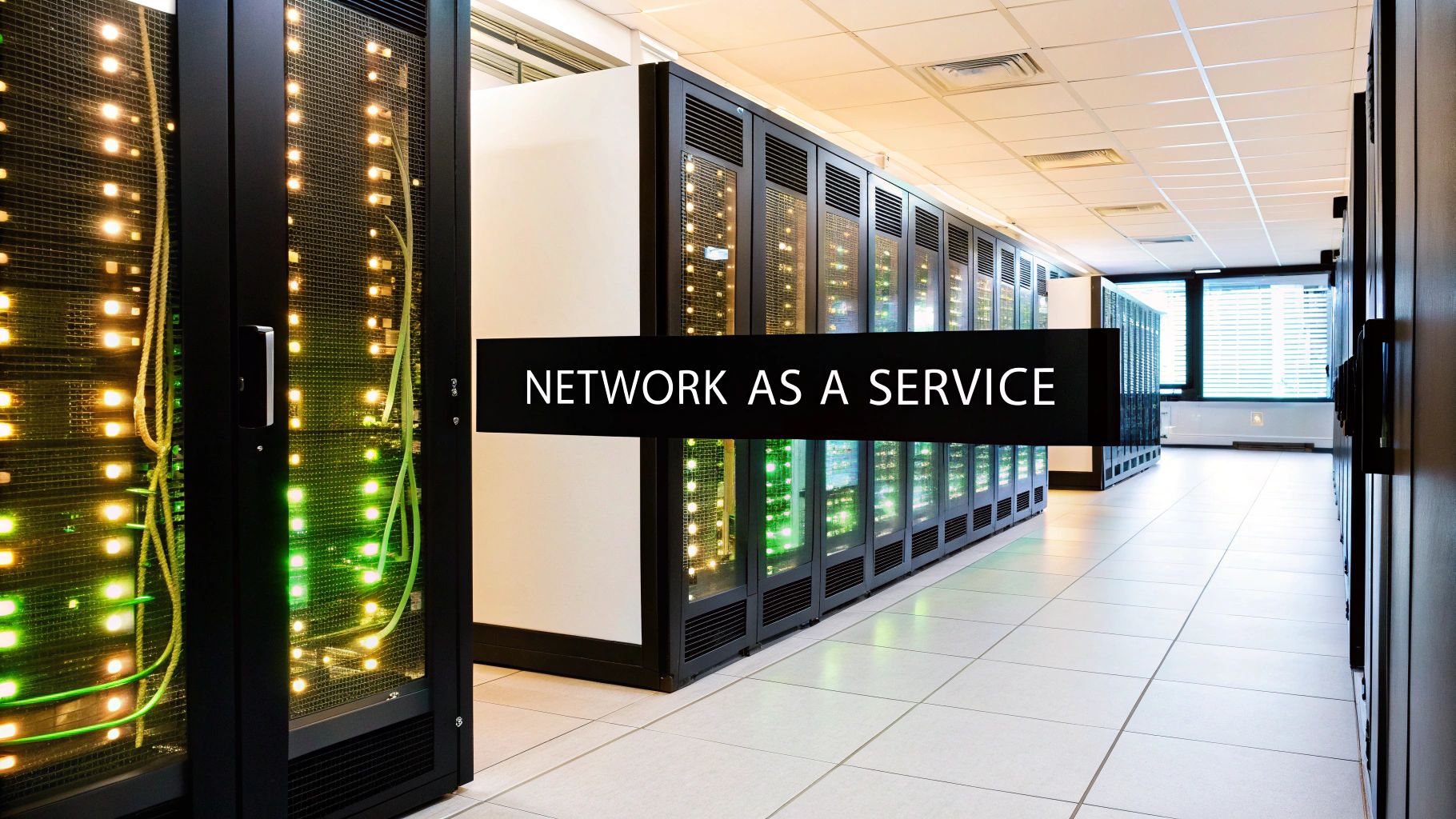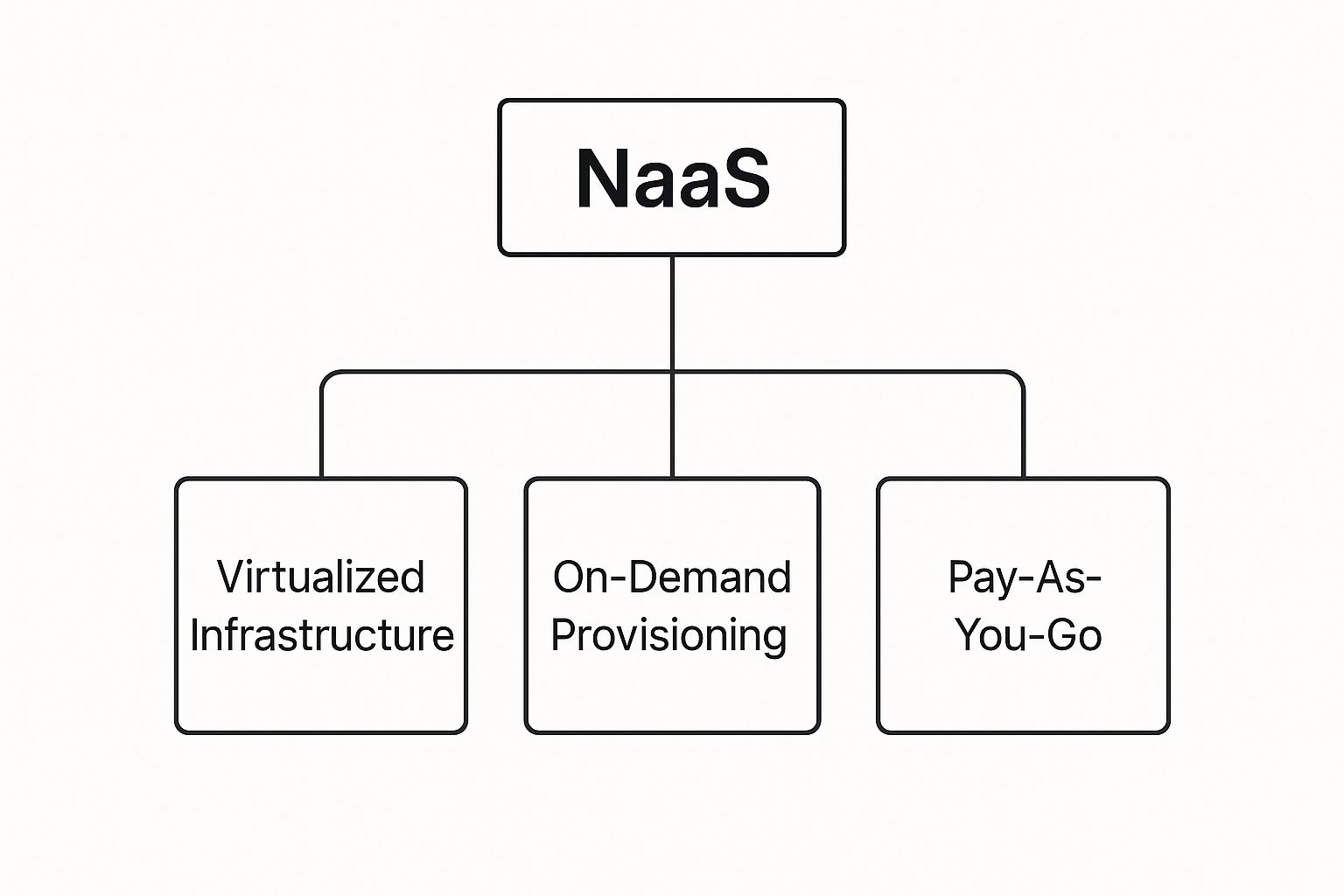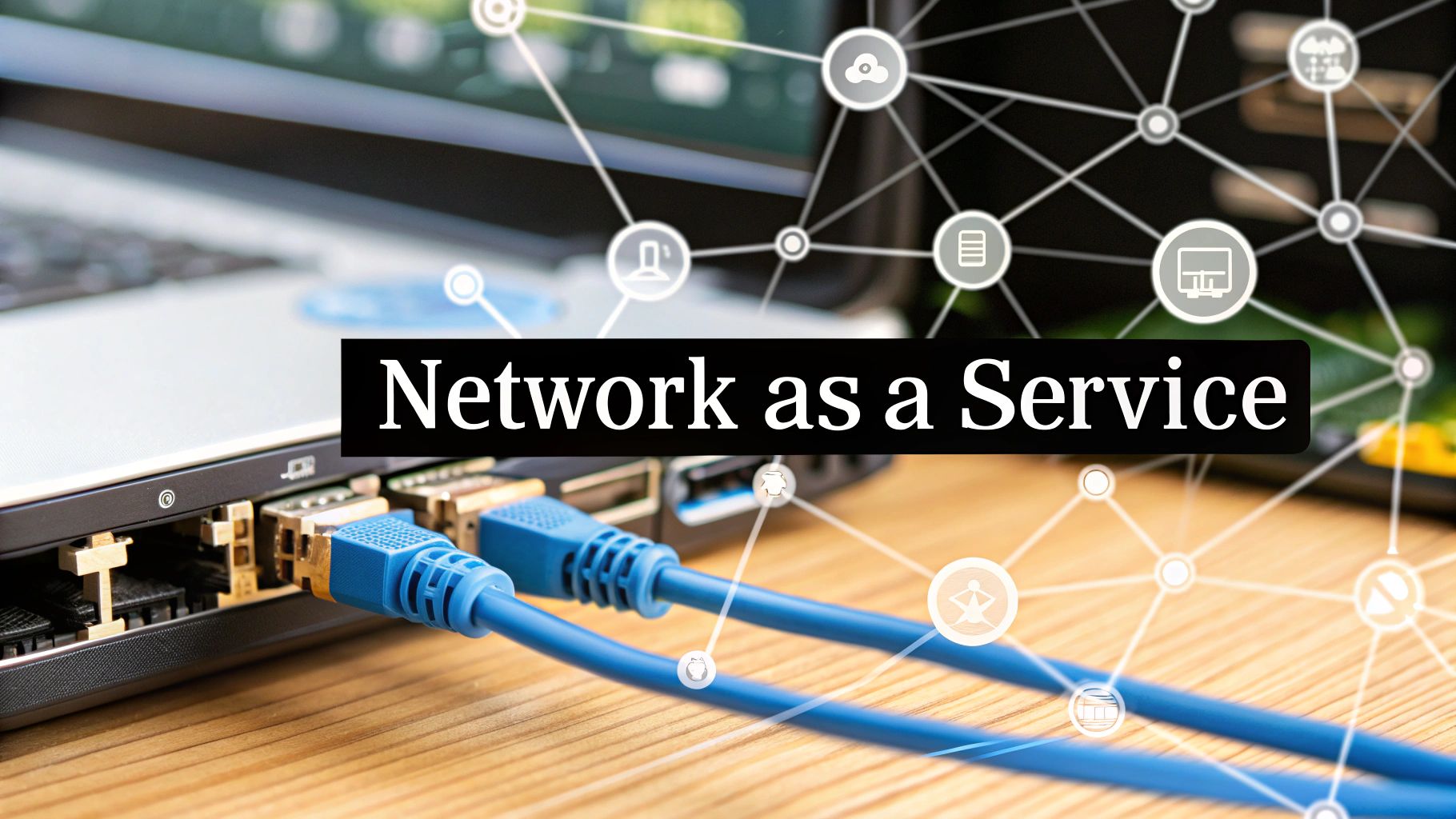Think about how you use a service like Netflix or Spotify. You don’t buy DVDs or CDs anymore; you pay a simple subscription and get instant access to a massive library of content, anytime, anywhere. Network as a Service (NaaS) applies that exact same logic to your company’s network.
Instead of buying, configuring, and maintaining all the physical routers, switches, and firewalls yourself, NaaS delivers your entire network as a flexible, on-demand service. This simple but powerful shift turns networking from a huge upfront investment into a predictable monthly operational cost.
A New, Simpler Way to Build Your Network

The old way of building a business network was a real headache. You had to sink a lot of cash into expensive hardware, then deal with complex installations and the constant burden of maintenance. This traditional approach created a rigid network that couldn’t keep up with modern business demands, like quickly setting up a new branch office or securely connecting a growing remote workforce.
NaaS completely flips that model around. It hides all the underlying hardware complexity behind a simple, centralized software portal. This gives you the kind of agility that’s essential for thriving in today’s fast-moving business world.
From Owning Hardware to Consuming a Service
At its heart, understanding NaaS is about grasping the move away from owning physical gear and toward consuming networking as a utility. This change in mindset brings some major wins right out of the gate:
- Predictable Costs: Say goodbye to massive capital expenditures (CapEx). With NaaS, you have a consistent monthly operational expense (OpEx) that’s easy to budget for.
- Simplified Management: Your IT team is no longer bogged down with patching switches or troubleshooting hardware failures. They can finally focus on projects that actually move the business forward.
- Instant Scalability: Need more bandwidth for your busy season? Opening a new project site? NaaS lets you scale your network resources up or down with just a few clicks.
This subscription approach is a big reason why NaaS is catching on so quickly. A well-executed NaaS strategy can lead to a 35% reduction in network operational costs and a stunning 60% improvement in deployment times.
To illustrate the difference, let’s compare the two approaches side-by-side.
Traditional Networking vs. Network as a Service (NaaS)
| Aspect | Traditional Networking | Network as a Service (NaaS) |
|---|---|---|
| Model | Ownership (Capital Expense – CapEx) | Subscription (Operational Expense – OpEx) |
| Procurement | Purchase physical hardware and software licenses upfront. | Consume network resources as a monthly or annual fee. |
| Management | In-house IT team manages hardware, updates, and troubleshooting. | Provider manages all underlying infrastructure and maintenance. |
| Scalability | Rigid and slow. Requires new hardware purchases for expansion. | Flexible and fast. Scale up or down through a software portal. |
| Technology | Hardware becomes obsolete; requires periodic, costly refresh cycles. | Provider handles all hardware refreshes and software updates. |
| Flexibility | Difficult to adapt to new business needs like remote work or IoT. | Natively supports agile, distributed, and cloud-first environments. |
As the table shows, NaaS frees you from the cycle of buying and managing hardware that will eventually become outdated.
The core idea of NaaS is to deliver networking using cloud-native principles. Just as compute and storage moved into abstracted, scalable, usage-based services, networking is undergoing the same essential transformation.
Instead of being locked into hardware that ages out, NaaS gives you a future-proof solution. The provider takes care of all the hardware refreshes and software updates, ensuring your network always has the latest capabilities and security protections.
This model helps companies become more agile, secure, and cost-efficient. To explore the advantages further, you can learn more about how NaaS benefits businesses in our detailed guide.
Why Is NaaS Catching On Now? The Forces Shaping the Market

The rapid rise of Network as a Service isn’t happening by chance. It’s a direct answer to some of the biggest shifts we’ve seen in how businesses work. Several powerful market trends are coming together, turning the agility and simplicity of NaaS from a nice-to-have into an absolute must for staying competitive. Simply put, traditional networking just can’t keep pace anymore.
The market growth tells the story. Valued at $18.10 billion today, the global NaaS market is expected to surge to $230.10 billion by 2034. That’s a compound annual growth rate (CAGR) of about 28.95%, a clear sign that businesses are actively leaving old, rigid networking models behind. You can dive deeper into these numbers and learn more about the NaaS market growth on Precedence Research.
So, what’s behind this massive shift? It boils down to a few key pressures.
The Digital Transformation Imperative
First and foremost is the company-wide push toward digital transformation. Businesses are moving their essential operations online, launching new apps, and gathering huge amounts of data to make smarter choices. This creates an enormous need for a network that is both incredibly flexible and powerful.
A static, hardware-based network just becomes a bottleneck. It’s like trying to run a bullet train on old, rickety tracks—it’s not going to work. NaaS provides the modern, adaptable infrastructure that a digital-first strategy demands, letting organizations innovate without being held back by their network.
The Permanently Distributed Workforce
The second major driver is the explosion of remote and hybrid work. The old idea of a single, secure corporate headquarters is a relic. Today, the “office” is wherever your employees are—a spare bedroom, a coffee shop, or a co-working space on another continent.
This creates a huge headache for old-school networks. Trying to give thousands of individual locations secure, reliable, high-performance connectivity with traditional hardware is a logistical nightmare.
NaaS solves this by neatly extending the corporate network to any user, anywhere, with consistent security and performance. It effectively treats every connection point as a micro-branch of the main office, all managed from a single, central dashboard.
The Deep Dive into Cloud Services
Finally, the widespread adoption of cloud services like Software as a Service (SaaS) and Infrastructure as a Service (IaaS) has made network agility non-negotiable. Businesses now depend on a mix of applications running in their own data centers and across multiple public clouds.
A rigid network struggles to efficiently route traffic between these scattered environments, which leads to slow performance and frustrated users. NaaS, on the other hand, is built for this multi-cloud reality. It creates a seamless, software-defined layer that intelligently connects all your resources, making sure applications run smoothly no matter where they live.
This combination of forces explains why the question of what is network as a service has become so urgent. It’s the answer to the core challenges modern businesses are wrestling with:
- How do we support constant innovation and change?
- How do we secure a workforce that is literally everywhere?
- How do we build a network that’s truly designed for a cloud-centric world?
NaaS isn’t just another tech trend; it’s a fundamental pillar for any company that wants to compete. It’s the engine that powers other critical technologies, from the Internet of Things (IoT) to artificial intelligence (AI), making it an essential building block for future growth.
How The NaaS Model Actually Works
To really get what NaaS is all about, you have to look under the hood. The best way to think about it is by comparing it to cloud platforms most of us are familiar with, like Amazon Web Services (AWS) or Microsoft Azure. You never see or touch the physical servers, right? You just use a simple dashboard to spin up whatever you need. NaaS does the exact same thing for your network.
It all starts with the physical infrastructure—the actual routers, switches, access points, and cables. With a NaaS model, the provider (like Clouddle) owns and manages all of it. That means your IT team is completely off the hook for dealing with hardware refreshes, maintenance, and all the headaches that come with it.
The real secret sauce, though, is the virtualization layer that sits on top of all that hardware. This is where clever software comes into play, creating a virtual pool of networking resources. It detaches network functions from specific physical boxes, making the entire system flexible and programmable.
The Power of Software-Defined Control
So, how does this virtualization work its magic? It boils down to two key technologies: Software-Defined Networking (SDN) and Network Functions Virtualization (NFV).
- Software-Defined Networking (SDN): This is the technology that splits the network’s “brain” (the control plane) from its “muscles” (the data plane). The control plane decides where traffic should go, while the data plane just forwards it. This allows an administrator to manage traffic flow and policies from a central software controller instead of manually logging into dozens of individual devices.
- Network Functions Virtualization (NFV): This takes services that used to require their own dedicated hardware box—things like firewalls, load balancers, or VPN gateways—and turns them into software. These virtual services can then be run on standard server hardware, making it incredibly fast to deploy or change them as needed.
When you put SDN and NFV together, you get a network that is smart, responsive, and easy to program. The final piece of the puzzle is the orchestration software. This is the user-friendly portal or API that your IT team actually interacts with.
From this single dashboard, they can do things that used to take weeks of planning and manual work. Need to bring a new branch office online? A few clicks. Need to boost bandwidth for a big event? Done. Deploy a new security policy across the entire company? Easy. No more truck rolls or late nights configuring hardware.
The whole point is to shift your network from a static collection of manually configured hardware into a dynamic, automated service. NaaS uses automation to deliver what you need, when you need it, which lines up perfectly with modern IT Service Management automation practices.
Visualizing the NaaS Hierarchy
This diagram gives you a clear picture of the simple, three-tiered structure that makes the NaaS model work.

As you can see, it all starts with a virtualized infrastructure that enables on-demand services delivered through a pay-as-you-go model.
This new approach completely changes the day-to-day reality for your network team. They’re freed from the endless cycle of tedious, repetitive tasks. Instead of spending a month planning a new site deployment, they can get it up and running in a few hours. That reclaimed time is a huge win, allowing them to focus on bigger projects that actually move the business forward.
If you want to explore this further, our post on how Network as a Service enhances business operations offers a deeper look into the operational benefits.
The bottom line is that NaaS makes your network operate just like a cloud service—it’s agile, scalable, and you only pay for what you use. It’s a major departure from the rigid, expensive networking models of the past, giving your business the ability to adapt at the speed of the market.
What Can NaaS Actually Do for Your Business?

It’s one thing to understand the technical side of Network as a Service, but the real question is how it helps your bottom line. The truth is, the technical advantages of NaaS aren’t just for your IT team; they translate directly into tangible business outcomes. Your network stops being a complicated cost center and becomes a strategic asset that actually fuels growth, efficiency, and security.
These benefits really crystallize when you look at them through four key areas: financial agility, operational simplicity, on-demand scalability, and next-generation security. Let’s break down why this model is compelling so many businesses to make the switch.
Gain Financial Agility and Predictability
The most immediate and powerful benefit of NaaS is the way it completely changes how you pay for your network. Traditionally, networking meant massive upfront capital expenditures (CapEx) for hardware. This approach ties up a ton of cash in equipment that starts losing value the second you plug it in.
NaaS flips that model on its head. It shifts your network costs to a predictable operational expenditure (OpEx) budget. You simply pay a flat monthly or annual subscription fee, just like you do for other cloud services.
This has a huge ripple effect on your financial planning:
- Freed-Up Capital: Instead of sinking money into depreciating hardware, you can invest it in core business activities like product R&D, marketing campaigns, or hiring key people.
- Lower Total Cost of Ownership (TCO): A good NaaS subscription bundles everything—hardware, software, maintenance, and support—eliminating the hidden costs of managing a network in-house.
- Predictable Budgeting: With a fixed subscription, you know exactly what your network will cost each month. No more surprise expenses. Budgeting becomes simpler and far more accurate.
The market’s explosive growth tells the story. Valued at $24.82 billion, the Network as a Service market is projected to skyrocket to $327.53 billion by 2033. This isn’t just hype; it’s driven by businesses demanding the agility to scale without the anchor of heavy upfront investment. You can see more on the growth of the NaaS market at Straits Research.
Achieve Operational Simplicity
Beyond the financial wins, NaaS radically simplifies your day-to-day IT operations. When you hand off the management of network infrastructure to a provider, you free your internal IT team from the endless cycle of patching, troubleshooting, and maintaining hardware.
Think about what they could do with that time. Instead of constantly putting out fires, they can finally focus on strategic projects that move the business forward. This could mean optimizing application performance, building new digital services, or strengthening the company’s overall security posture.
NaaS empowers your IT team to transition from being infrastructure caretakers to strategic business enablers. They can spend less time keeping the lights on and more time finding new ways for technology to create a competitive advantage.
Scale Your Network Instantly
Business needs are never static. One minute you’re opening a new branch office, the next you’re supporting a temporary project site or handling a seasonal surge in website traffic. With a traditional network, scaling to meet these demands is a slow, expensive, and frustrating process of ordering, shipping, and configuring new gear.
NaaS, on the other hand, delivers incredible scalability. Because the network is software-defined and cloud-based, you can scale your capacity and add new services up or down almost instantly.
- Retail: A retail chain can get a secure, standardized network up and running for a new store in a matter of days, not months.
- Seasonal Business: A tax firm can double its network capacity during the busy season and then scale right back down to save money the rest of the year.
This ability to adapt on the fly means your network never holds your business back. It grows and shrinks right alongside you. To dig deeper into this, you can check out our guide on managed network as a service and what you need to know.
Embed Next-Generation Security
In a world of remote work and increasingly sophisticated cyber threats, security can’t be an afterthought. Top-tier NaaS solutions are built with security baked in from the ground up, embedding advanced protection directly into the network fabric. Many providers, including Clouddle, build their services on a Secure Access Service Edge (SASE) framework.
This modern approach merges networking and security into a single, cloud-delivered service. It provides far better protection that’s managed from one place and applied consistently, no matter where your users or data are. This is all backed by robust service level agreements (SLAs) that guarantee both performance and security uptime.
Real-World NaaS Use Cases and Applications
The ideas behind Network as a Service are great on paper, but where does the rubber really meet the road? The true power of NaaS shines when you see how it solves real, tangible business problems. Moving to a consumption-based network isn’t just a technical swap-out; it’s a strategic shift that helps companies do things they simply couldn’t before.
From pop-up retail shops to life-or-death healthcare data, NaaS delivers the agile, secure, and scalable networking that modern business demands. Let’s look at a few examples of NaaS in action.
Rapid Retail Expansion
Imagine you’re the IT lead for a retail brand that’s taking off. The goal is to open 50 new stores in the next year. With a traditional network setup, that plan is a logistical nightmare. For every single store, you’d be stuck ordering hardware, waiting for technicians, manually configuring firewalls, and dealing with weeks of lead time. That kind of friction doesn’t just slow down IT; it slows down the entire business.
This is where a NaaS model completely changes the game.
- Set It and Forget It: Instead of reinventing the wheel 50 times, the IT team creates one master network profile in the NaaS portal. This template includes everything—Wi-Fi, point-of-sale rules, security policies, the works.
- Plug and Play: For a new store, all you do is ship a pre-configured device to the location. Someone plugs it in, it connects to the cloud, and it automatically downloads its entire configuration. The store is securely online in a matter of hours, not weeks.
- A Single Pane of Glass: Your IT team can now see and manage all 50 new stores—plus all the existing ones—from one central dashboard. This ensures every location has the same security posture and performance standards.
The result? You can open stores as fast as you can sign the leases, all while cutting deployment costs and giving every customer the same great, secure experience.
Secure and Compliant Healthcare Connectivity
A modern hospital system is a networking pressure cooker. You’ve got to connect the main hospital, scattered outpatient clinics, and a growing number of remote telehealth providers. At the same time, you’re shuffling massive files like MRIs and CT scans while staying on the right side of strict HIPAA regulations. The network has to be fast, reliable, and practically bulletproof.
NaaS is built for this kind of high-stakes environment. It can create a private, high-speed network that securely links every doctor, clinic, and specialist. Telehealth calls come through crystal-clear, and a radiologist can download a huge imaging file in seconds, not minutes.
With NaaS, healthcare organizations can easily build a network that completely isolates sensitive patient data from other traffic, like the public guest Wi-Fi. This kind of segmentation is a cornerstone of any serious security strategy and makes passing compliance audits much, much easier.
Smart Manufacturing and IoT Data Streams
Think about a massive factory floor that’s gone all-in on Industry 4.0. It’s now blanketed with thousands of IoT sensors tracking everything from robotic arms on the assembly line to the temperature in the paint booth. These sensors create a non-stop flood of data that needs to be collected and analyzed in real-time.
A traditional, aging network would choke on that much data. NaaS, on the other hand, can scale to handle it. It allows manufacturers to build a robust network that can handle the massive data streams from IoT devices without slowing down the rest of the business. This means they can spot maintenance issues before a machine breaks, fine-tune production lines on the fly, and operate with a whole new level of insight.
The world is catching on fast, especially in manufacturing. The Asia-Pacific region is a hotbed for adoption, with NaaS growing at a CAGR of roughly 28.9%. Small and medium businesses are jumping on board even faster, with subscriptions growing around 30.1% annually, thanks to simple, turnkey packages that avoid huge upfront costs. You can discover more insights about NaaS market growth trends at Mordor Intelligence.
Resilient Financial Services Branches
For a bank, a network outage isn’t an inconvenience—it’s a crisis. If a branch loses its connection, transactions stop, customers can’t access their accounts, and the firm’s revenue and reputation take an immediate hit. Whether it’s a trading floor or a local branch, financial firms need networks that are always on, always secure, and always compliant.
NaaS provides this kind of resilience by design. It can intelligently and automatically route traffic over multiple connections—say, a primary fiber line and a cellular 5G backup. If one link goes down, the network seamlessly fails over to the other, and no one in the branch even notices. Security is baked in from the start, with end-to-end encryption and controls that meet the strict regulations of the financial world. It delivers the rock-solid, always-on connectivity these institutions can’t live without.
What Makes the Clouddle NaaS Experience Different?
The basic idea of Network as a Service is a great starting point for modernizing how businesses connect. But like any good idea, the real value comes down to how it’s put into practice. At Clouddle, we’ve built our NaaS solution to be more than just a standard offering. We focused on creating a genuinely seamless, smart, and secure network environment that truly helps your business succeed.
Many providers might give you a few pieces of the puzzle, but Clouddle brings it all together. Instead of trying to manage different vendors for your networking, security, and cloud access, our clients get everything from a single, easy-to-use platform. This integrated design gets rid of the headaches and blind spots that pop up when you’re piecing together solutions from multiple companies.
A Unified Platform for Effortless Control
Our entire solution is built on a powerful, unified management portal that makes even the most complicated network tasks feel simple. This is where Clouddle really shines. From this one dashboard, you can see and manage your entire network—from your data centers to branch offices and even remote employees—without needing to be a networking guru.
This level of centralized control frees up your IT team. They can finally stop putting out fires and start working on projects that actually move the business forward. We’ve made network management straightforward, effective, and accessible.
AI-Driven Assurance for Proactive Performance
Clouddle’s NaaS isn’t just about making connections; it’s about making sure those connections are always fast and dependable. We’ve built advanced, AI-driven assurance right into the platform. This system doesn’t just sit around waiting for a problem to happen. It actively monitors network health, spots potential issues, and often fixes them before anyone even notices.
This proactive approach is the difference between a network that simply works and a network that actively works for you. It guarantees performance, minimizes downtime, and gives you the peace of mind that your operations are always running smoothly.
Built-in SASE for Ironclad Security
With Clouddle, security isn’t an afterthought or an add-on; it’s baked into the very core of our architecture. We integrate a complete Secure Access Service Edge (SASE) framework directly into our NaaS. This design solves the major security and visibility gaps that many businesses struggle with when using other solutions.
Our built-in SASE includes:
- Zero Trust Principles: We grant access based on strict identity verification, never just on network location.
- End-to-End Encryption: Your data is protected at all times, whether it’s moving across the network or sitting on a server.
- Unified Threat Management: You get a full suite of security services, all managed from one central policy engine.
This approach means your entire network is protected by a consistent, enterprise-grade security policy everywhere, without the complexity of trying to bolt on separate security products. With Clouddle, you get seamless integration with all major cloud providers and a foundation ready for what’s next, like private 5G and advanced edge computing. We see ourselves as more than just a vendor; we’re your partner in growth.
Commonly Asked Questions About NaaS
Whenever a business starts looking into Network as a Service, the same set of questions almost always pops up. And that’s perfectly normal. Switching up your entire networking approach is a big deal, so it’s smart to dig into the practical details.
Let’s clear the air and tackle the most common uncertainties, from how NaaS fits in with technologies you already know, like SD-WAN, to what this shift means for your IT pros on the ground.
Is NaaS the Same as SD-WAN?
This is probably the most frequent—and important—question we hear. The short answer is no, but they’re definitely related.
Here’s a good way to think about it: SD-WAN is a powerful ingredient, but NaaS is the complete, chef-prepared meal delivered right to your table.
- SD-WAN (Software-Defined Wide Area Network) is a specific technology. It’s the software brain that makes your wide area network smart and flexible, directing traffic efficiently. It’s a key piece of the puzzle.
- NaaS (Network as a Service), on the other hand, is the full service model. It takes that SD-WAN technology and bundles it with all the hardware, software licenses, ongoing management, and expert support you need, all for a single subscription fee.
So, while most NaaS solutions have SD-WAN at their core, NaaS is the all-encompassing service that manages the entire network for you.
What Happens to My Existing Network Team?
It’s a valid concern. When you hear “outsourced network,” it’s easy to worry that your talented IT team might become obsolete. In reality, the opposite is true. Adopting NaaS doesn’t replace your team; it elevates their role.
Think about all the time they spend on the daily grind—patching switches, troubleshooting hardware failures, and wrestling with mind-numbing configurations. NaaS takes that operational burden off their plate.
This frees them up to focus on what really matters: strategic, high-impact work. They can now dedicate their expertise to improving application performance, designing stronger security policies, and making sure the network is perfectly aligned with the company’s biggest goals. It’s a shift from “keeping the lights on” to driving real business value.
How Secure Is a Network as a Service Solution?
Top-tier NaaS solutions are built from the ground up to be incredibly secure—often more so than a traditional, self-managed network. Security isn’t treated as a bolt-on feature; it’s baked into the core of the service.
Modern NaaS platforms are designed around advanced security architectures like SASE (Secure Access Service Edge). This framework doesn’t just connect your network; it protects it by integrating a full stack of security tools like Zero Trust Network Access (ZTNA) and Firewall as a Service (FWaaS). Better yet, it’s all managed and kept up-to-date by the provider’s dedicated security experts.
Ready to transform your network with the simplicity and security of a modern service model? Clouddle offers a superior NaaS experience with AI-driven assurance and a built-in SASE framework. Discover our flexible, zero-down payment solutions at https://www.clouddle.com.


